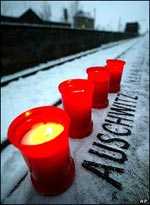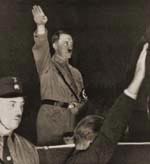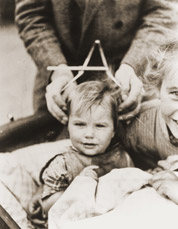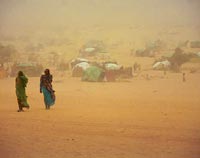| (insert your NIE or newspaper logo here) | Weekly Online LessonOnline Lesson ArchiveGrade Level: 7-10
|
Genocide: Past & Present
 Try
to imagine being locked up in prison for a year or more.
Try
to imagine being locked up in prison for a year or more.
In the United States, that would most commonly mean that you would eat meals, maybe watch television, write, draw, exercise, etc. to pass the time. And you'd be there because a judge or jury found you guilty of committing a crime that mandated you be sentenced to prison.
Now imagine being locked up because of your ethnic heritage or personal beliefs. Imagine feeling the pains of starvation, disease, and unethical medical experiments every moment of every day. Imagine witnessing loved ones -- including children -- herded into a building, never to return.
That nightmare was a reality for millions of people -- particularly Jews and other minorities -- in Nazi Europe during World War II. During this era, referred to as the Holocaust, millions of people were driven into prison camps, tortured and killed. Lucky ones were hidden by resident sympathizers or found refuge beyond the borders of Adolf Hitler's grip.
This genocide -- basically meaning, the specific targeting and eradicating of a group of people by another -- finally ended with the defeat of the Nazis and their allies in 1945.
On Monday, January 24, 2005, the United Nations held its first ceremony commemorating the liberation of the largest Nazi extermination camp, Auschwitz-Birkenau. Sixty years have passed, but tears still come to those who walked out of there alive.
 Many
experts believe that fewer people would have died, if the rest of the
world had paid more attention to the genocide being committed and acted
more quickly to stop it.
Many
experts believe that fewer people would have died, if the rest of the
world had paid more attention to the genocide being committed and acted
more quickly to stop it.
Three years after the war, the U.N. adopted the Convention on the Prevention and Punishment of the Crime of Genocide, which clearly defined the meaning of "genocide" and, theoretically, was designed to avoid similar tragedies in the future.
Despite this policy, some experts, like U.N. Secretary General Kofi Annan, believe that inattention and inaction still occurs today, allowing similar events of genocide to continue.
"Since the Holocaust, the world has, to its shame, failed more than once to prevent or halt genocide," Annan said during Monday's ceremony.
He noted specific cases including Cambodia in the 1970s, Rwanda and regions in the former Yugoslavia during the 1990s, and the current crisis in Sudan.
Unfortunately, the answers of how exactly to go about enforcing the U.N. policy remain intangible.
Most people are certainly distressed by genocide, but the act of stopping it is complex, as you'll soon discover in this week's lesson. You'll learn more about what led to the Nazi's genocide campaign and how it affected millions of people worldwide. You'll also compare that to the current events happening in Darfur, Sudan.
The Nazi Plan
 For
this week's lesson, you'll spend most of your time at the United
States Memorial Holocaust Museum in Washington, D.C.
For
this week's lesson, you'll spend most of your time at the United
States Memorial Holocaust Museum in Washington, D.C.
First, let's get oriented by Mapping the Holocaust. Under the heading, World War II, click to See Animated Map. Read the introduction, then click Start. Afterward, click for the animated map under The Holocaust.
For further detail about how these events unfolded, read the Introduction to the Holocaust, then learn more about the Mosaic of Victims, the "Final Solution", and the Camp System.
What were some reasons that the Nazis wanted to exterminate Jews and other groups of people? How did they create the infrastructure to carry out these projects?
In addition to simply getting rid of the "undesirables," the Nazis were Creating the Master Race and refining "racial hygiene".
Start your exploration of Deadly
Medicine by listening to or reading the curator's o verview.
verview.
Then, scroll down the page and begin with the first section, Science of Salvation, 1919-1933. You can stop to Examine Key Artifacts throughout the exhibit.
What does the term "eugenics" mean? How exactly did scientists determine which characteristics made a person a "biological threat"? Do you think that any aspect of the eugenics program was acceptable?
Next, browse the Biological State, 1933-1939.
How did the Nazi powers persuade people to support the eugenics policy? Why was it important for the Nazis to control the educational and cultural institutions, as well as the media? In what ways do you think these measures shaped a person's daily life? How did these events in Europe affect the United States?
These events further escalated into the Final Solutions, 1939-1945.
In what ways did the Nazis go about shaping Poland to their liking? Why do you think they pushed the "unfit" people into ghettos? What special characteristics could allow an individual to live and under what conditions?
Should the United States and other nations have been more concerned about the situation sooner? If so, what could possibly have been done to avoid the massive loss of life?
Surviving Auschwitz, Darfur
 Now,
let's get a more person viewpoint from survivors of Auschwitz.
Now,
let's get a more person viewpoint from survivors of Auschwitz.
Begin by reading the introduction on the left-hand side, and View more photos and Play animation.
Next, read or listen to the Testimony of Ruth Webber, Fritzie Fritzshall, Bart Stern. For more testimonies, click on the thumbnails in the gallery located at the top of Bart Stern's window.
Make sure to also watch each Film showing historic footage. In what ways did the Germans use humans as "natural resources"? Why do you think twins were important for certain research?
Let's move from the past to the present, and from Europe to Africa -- more specifically, Darfur in Sudan, where you'll get a chance at Staring Genocide in the Face. While not a pretty picture, it's important to see and understand what's happening there.
 Scroll
down past the photo gallery to read an overview of the situation. Why
would the Arab government want to rid its country of Africans?
Scroll
down past the photo gallery to read an overview of the situation. Why
would the Arab government want to rid its country of Africans?
Now go back to the top of the page, and click Start Commentary then Play Commentary to run the slideshow.
How are the conditions affecting the health of the people? What happened to the men and boys of these populations? How exactly is the Arab militia pushing Africans out of Darfur? Under the U.N. convention, can the actions by the militia and Sudanese government be defined as "genocide"?
How do the refugee camps compare to the World War II ghettos? What conditions and dangers are similar and which are different between these refugees and those persecuted by the Nazis?
If you'd like to learn more about the Holocaust, check out the rest of the museum's Online Exhibits and Special Focus section.
Newspaper Activities
Watch current issues of The Salt Lake Tribune for articles related to the persecution of one people by another, either historic or current. What reasons did the persecutors offer for justifying their actions? What have been the consequences of their actions -- politically, socially, mentally, physically, and emotionally? What are organizations, like the U.N., doing about these violations of the law? How are different governments reacting to the situation, including the United States?
© Copyright 2005
Learners Online, Inc.
